A highly selective marker reaction for measuring the activity of human carboxylesterase 1 in complex biological samples†
Abstract
Human carboxylesterase 1 (hCE1), plays pivotal roles in endobiotics homeostasis and xenobiotic metabolism. The plasma level of hCE1 could serve as a useful serologic biomarker for several hepatic diseases, such as hepatocellular carcinoma. However, no probe reaction has been fruitfully used to determine the activity of trace hCE1 in human plasma. This study aims to design and develop a highly selective marker reaction for measuring the enzymatic activities of hCE1 in complex biological samples including human plasma. N-(4-Methyl butyrate)-4-hydroxy-1,8-naphthalimide (NMHN), which contains a small alcohol group and a large acyl moiety, was intentionally designed based on the substrate preference of hCE1. NMHN could be easily hydrolyzed by hCE1 with very high catalytic efficacy under physiological conditions, while both reaction-phenotyping assays and chemical inhibition assays demonstrated that this reaction exhibited super selectivity towards hCE1 over other human hydrolases. Furthermore, the marker reaction possessed ideal kinetic behaviour (classic Michaelis–Menten) with high intrinsic clearance (5.8 mL min−1 mg−1). Based on this probe, a rapid hCE1 quantification method was developed and fully validated, which was successfully applied to determine the real activities of hCE1 in various biological samples including human plasma. Our findings afforded a promising tool for measuring the real activity of hCE1 and laid a solid foundation for further investigations on the biological functions of hCE1 in complex biological samples.


 Please wait while we load your content...
Please wait while we load your content...